- Why Vintage Interior Design Still Has My Heart - September 3, 2025
- Still in Love with Traditional Design – And Here’s Why - September 3, 2025
- The Enduring Charm of English Country Design: Why This Style Never Goes Out of Fashion - September 2, 2025
Table of Contents
Sarah from next door poked her head over the fence yesterday while I was sanding down this massive barn door. “Another old piece of junk for a client?” she laughed. I held up the door, the gorgeous chestnut one with original iron hardware…and watched her expression change, “Oh wow, that’s actually beautiful.”
That reaction happens a lot in my line of work. People see weathered wood or old stone and think “damaged goods.” But there’s magic in materials that have lived a little.
I’ve been doing this interior design thing for over twenty years now. Seen trends come and go faster than I can keep track of. But rustic design? It just keeps plugging along, reliable as an old pickup truck.
What Rustic Really Means (Spoiler: It’s Not Mason Jars Everywhere)
Real talk – most people get rustic completely wrong. They think it means buying everything distressed from HomeGoods and calling it a day. Actual rustic design happened because people didn’t have choices. You lived in rural Montana in 1890, you built with what was around – local timber, stones from the creek, whatever metal the town blacksmith could hammer out. Nobody was trying to make a design statement. They were just trying to build sturdy stuff that would last.
But something beautiful happened in that process. Wood kept its natural character with all its imperfections and grain patterns. Stone looked like it belonged to the landscape it came from. Metal showed the marks of being shaped by human hands rather than machines. That’s what we’re really after in rustic design – things that feel authentic and handcrafted, not mass-produced and manufactured to look “perfectly imperfect.”
The Good Stuff: Materials That Actually Work
Wood That’s Lived a Life
Forget Home Depot lumber. You want wood with history written all over it – barn siding with nail holes that tell stories, fence posts gone silver-gray from decades of weather, beams with saw marks from when they were first cut by hand a century ago. I found some incredible wormy chestnut beams last spring, and the client took one look and said they were “too rough.” Six months later, those beams are the first thing everyone notices in her living room, and she calls them her favorite part of the whole house now.
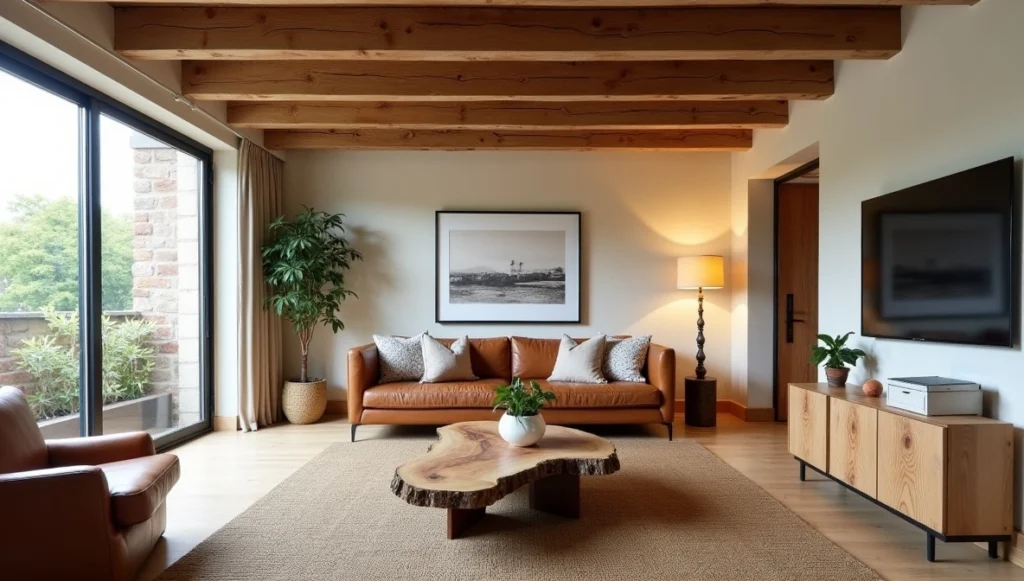
New wood can work too, but you’ve got to be picky. Look for pieces that embrace their natural imperfections – live edges, interesting grain patterns, knots that add character instead of looking like manufacturing defects. The goal is finding wood that looks like it has a story to tell, not wood that’s been processed into sterile perfection.
Stone with Stories
There’s something grounding about using materials pulled straight from the earth. River rock, fieldstone, slate – they connect indoor spaces to the landscape outside without trying too hard.
Just finished a kitchen where we used limestone the homeowner’s grandfather quarried from their property back in the 1940s. Every time they make coffee, they’re literally surrounded by their family history. Can’t buy that at a tile shop.
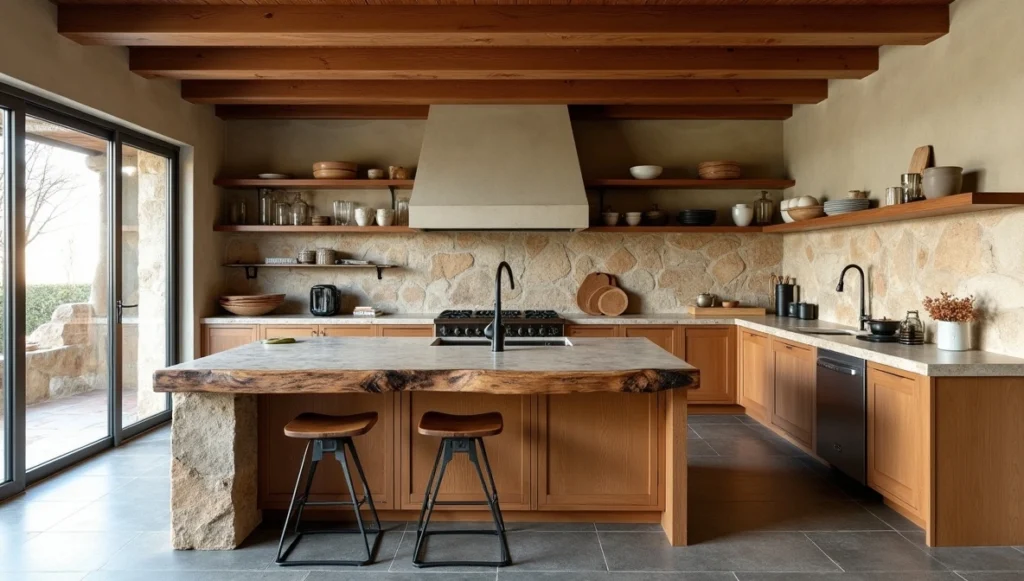
Metal with Character
Shiny, perfect finishes feel wrong in rustic spaces. What you want is metal that shows its age – iron with some honest rust, copper that’s developed that gorgeous green patina, steel gone soft and dark.
Hardware should feel substantial. Like someone made each piece individually rather than stamping out thousands in a factory. Door handles that have some weight to them. Cabinet pulls that look hand-forged. Light fixtures with character instead of catalog perfection.
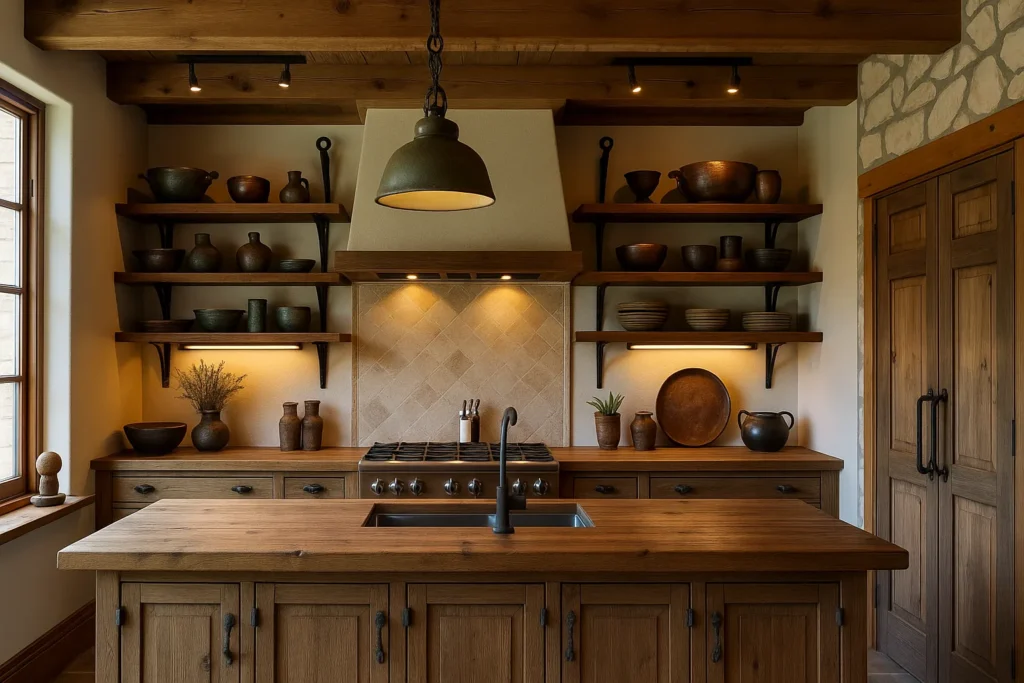
Room-by-Room Reality Check
Living Rooms That Actually Work for Living
Start with one knockout piece and build around it – maybe a coffee table cut from a single massive tree trunk, or a stone fireplace that looks like it’s been there since the house was built. Comfortable beats matching every time, and that leather sofa is going to look better in five years when it’s got some wear on it. Add a wool throw, maybe some linen pillows, but don’t go crazy turning it into a Pottery Barn catalog.
I had a client who wanted every single thing to match exactly, he desired same wood stain, same hardware finish, same everything. The room ended up looking like a furniture store display instead of someone’s actual home. The best rustic rooms look like they came together over time, with pieces collected from different places and different eras, not like someone wrote one big check and bought everything the same weekend.
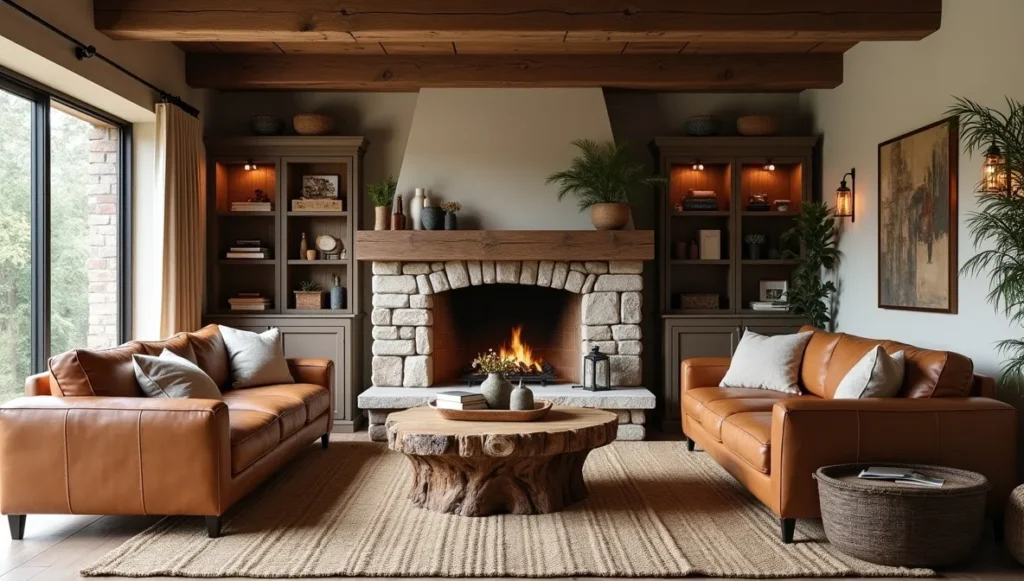
Kitchens Built for Real Cooking
Rustic kitchens need to handle spills, heat, and daily chaos. Those open shelves look great on Pinterest, but make sure you can actually reach the stuff you use every day.
Butcher block counters are gorgeous and practical if you take care of them. Farmhouse sinks handle big pots and messy prep work. Subway tiles with dark grout hide the inevitable splatters.
One thing that drives me nuts is people who make everything look ancient. Your kitchen still needs to work in 2025. You can hide modern appliances behind rustic facades if you want, but don’t sacrifice function for Instagram likes.
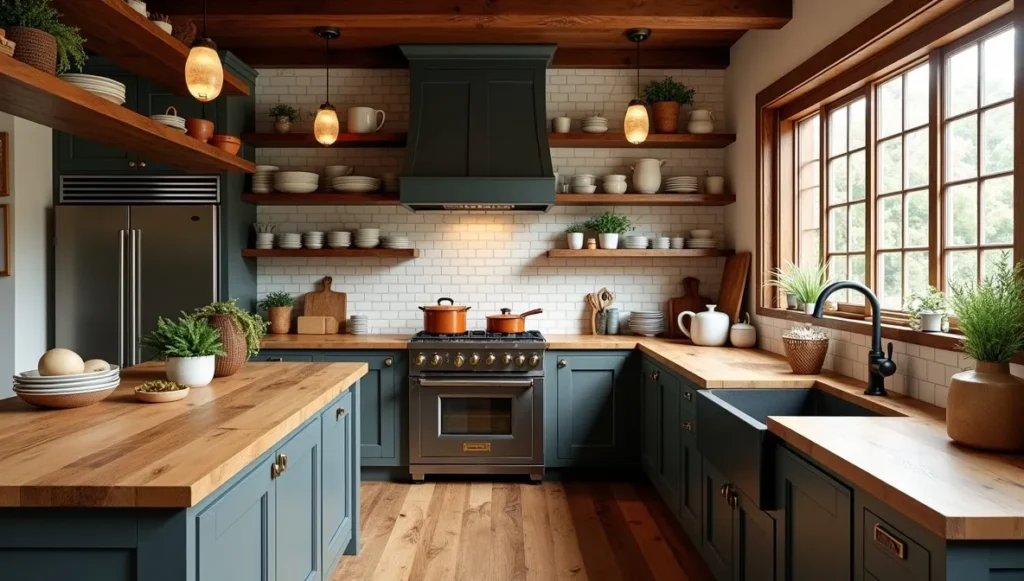
Bedrooms for Sleeping (Novel Concept)
Keep it simple. Solid wood bed frame that looks like someone made it by hand, not a machine. Layer your bedding – cotton sheets, linen covers, maybe a wool blanket your grandmother would recognize.
Overhead lighting is harsh and unwelcoming. Table lamps with warm bulbs create the kind of gentle glow that actually helps you relax.
Storage gets forgotten in rustic bedrooms. Old trunks at the foot of the bed aren’t just decorative, they hold stuff. Vintage dressers with original hardware beat anything you’ll find at Ashley Furniture.
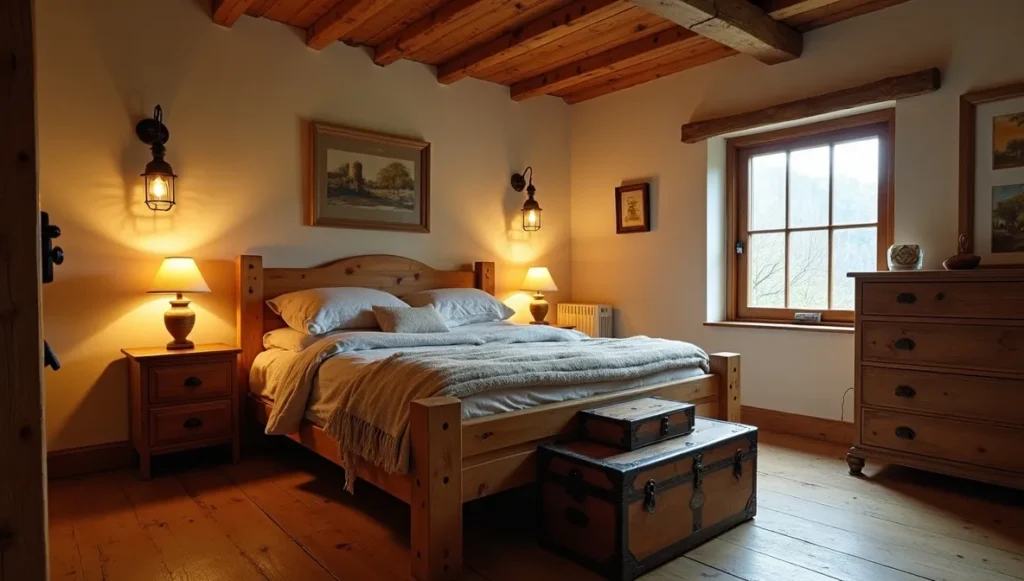
Bathrooms That Handle Reality
This is where people freak out. “But moisture! Won’t everything rot?”
Listen, people have been building bathrooms with wood and stone for centuries. You just need to be smart about it. Seal that reclaimed wood vanity properly. Choose stone that can handle humidity. Pick fixtures in finishes that get better with age, go with copper, bronze, anything that develops patina over time.
Converted an old dry sink into a bathroom vanity last year. Added a stone bowl on top, found some vintage-style faucets, and created something completely unique. Client still texts me photos of it.
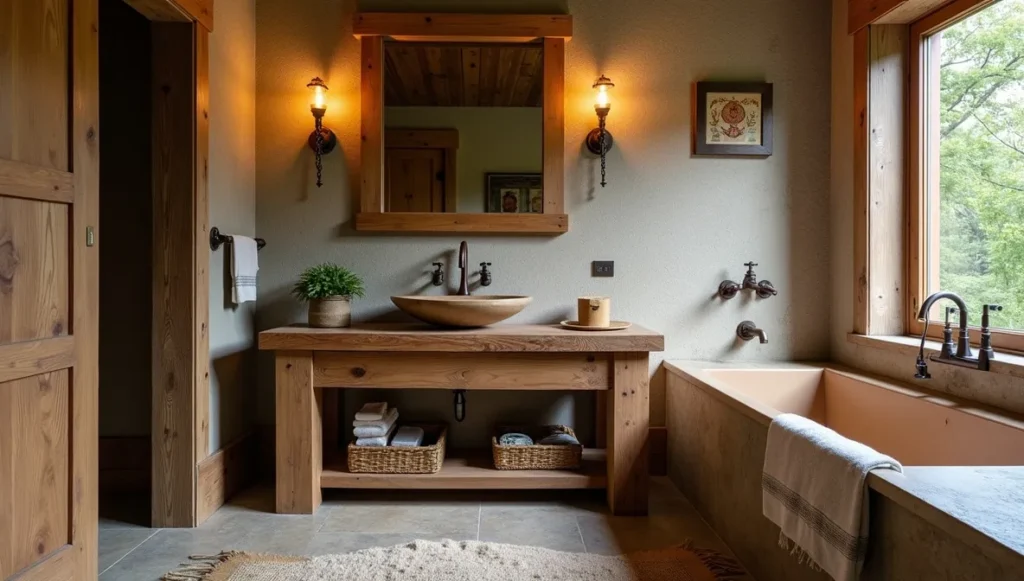
Home Offices with Personality
Working from home doesn’t mean your office has to look like corporate hell. A desk made from a live-edge wood slab beats any generic office furniture you’ll find online.
Old industrial pieces work great for storage without looking sterile. Books and plants on reclaimed wood shelves make the space feel human.
Goal is simple – create somewhere you actually want to spend eight hours a day, not just somewhere you have to work.
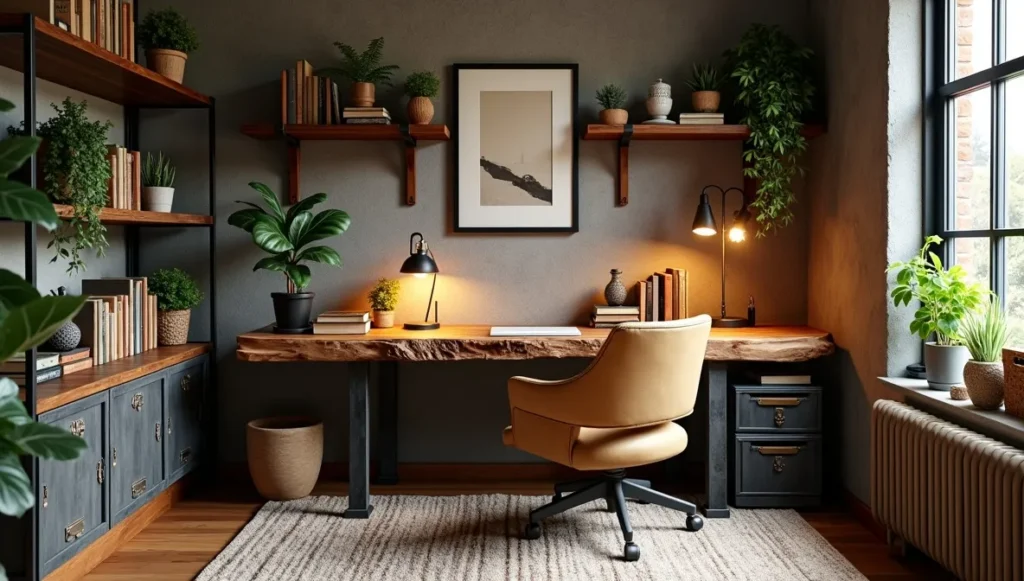
What Not to Do (Learn from Others’ Expensive Mistakes)
Don’t Build a Theme Park
Walked into a house last month that looked like a movie set. Horseshoes nailed to every wall. Fake cow skulls everywhere. Mason jars being used as soap dispensers, light fixtures, and probably toilet paper holders.
Real rustic design whispers instead of screaming. It should feel natural, not like you’re cosplaying frontier life.
Don’t Forget You Live in 2025
Rustic doesn’t mean uncomfortable. You still need decent lighting, storage that works, and furniture you can actually sit on. Challenge is hiding modern necessities without losing authenticity.
Don’t Buy Everything at Once
Best rustic rooms took years to put together. Hit estate sales, poke around salvage yards, browse Craigslist on Saturday mornings. Pieces with real character can’t be ordered online and delivered in two days.
Making It Work in the Real World
Old Meets New
Most interesting spaces mix vintage pieces with modern comfort. That antique farm table looks amazing with contemporary chairs. Your sleek sectional gets more personality next to a weathered wood coffee table.
Contrast keeps things from feeling like a museum exhibit.
DIY When It Makes Sense
Rustic style forgives imperfection, making it perfect for weekend projects. Build shelves from old fence boards. Turn vintage crates into storage. Make light fixtures from whatever interesting materials you find.
But don’t make everything a project. Sometimes buying quality pieces saves time and looks way better than homemade alternatives.
Finding the Good Stuff
Estate sales are goldmines. Salvage yards require digging through junk, but the finds are worth it. Craigslist takes patience. Facebook Marketplace is hit or miss.
Don’t automatically dismiss new pieces made to look old. Some companies specialize in authentic-looking aged finishes. Quality matters more than actual age – cheap fake distressing looks terrible immediately.
Why It Keeps Working
Maybe we’re all exhausted by perfection. Every surface polished to mirror shine. Every line ruler-straight. Every finish completely uniform.
There’s something deeply satisfying about materials that show their history. That dining table has seen decades of family meals. Those beams held up someone’s barn through countless storms.
In a world where everything’s disposable, surrounding yourself with stuff built to last feels meaningful.
Plus, rustic design is forgiving. Scratches don’t ruin the look – they add to the story. Try explaining that to someone who just spent five grand on a high-gloss modern dining set.
Regional Flavor
Rustic looks different everywhere. Southwest style uses adobe and terra cotta. Mountain cabins go heavy on logs and local stone. Coastal areas incorporate driftwood and weathered shingles.
Using materials that belong to your area makes everything feel more authentic. Don’t try creating Rocky Mountain vibes in South Florida – work with what makes sense locally.
Maintenance Truth
One huge benefit – rustic style is pretty low-maintenance. Most wear and tear actually improves the appearance.
That said, protect the structural stuff. Seal wood in wet areas. Clean stone before stains set in. But don’t panic about every scratch and ding. They’re part of the appeal.
Where Things Are Headed
Sustainability fits naturally with rustic design. Reclaimed materials reduce waste. Quality pieces that last generations make environmental sense.
Smart home tech keeps getting better at hiding. I’ve tucked speakers inside old wooden beams and hidden charging stations in vintage furniture. Key is integration that doesn’t scream “LOOK AT MY TECHNOLOGY.”
Starting Out
New to rustic? Start small. Replace a few light fixtures. Add some reclaimed wood shelving. Notice how these changes affect how the room feels.
Don’t rush to fill every corner. Best rustic spaces develop personality slowly as you find pieces that actually speak to you.
Hit up local salvage yards and estate sales. Talk to the people running them – they often know the stories behind pieces. Sometimes the history makes an item even more special.
The Bottom Line
Twenty-plus years of designing homes, and I keep coming back to rustic because it creates spaces that feel genuinely lived-in. Not perfect, not Instagram-ready, just comfortable and real.
It’s about homes that invite people to stay. Put their feet up. Gather around tables and share meals. Build memories in spaces that already hold so many stories.
Good design should make life better, not just look pretty in magazines. Rustic design does exactly that – creates homes that feel like homes, not showrooms.
And honestly? In our crazy, fast-paced, everything-digital world, we could all use a little more of that authentic, slow-down-and-breathe feeling in our lives.
